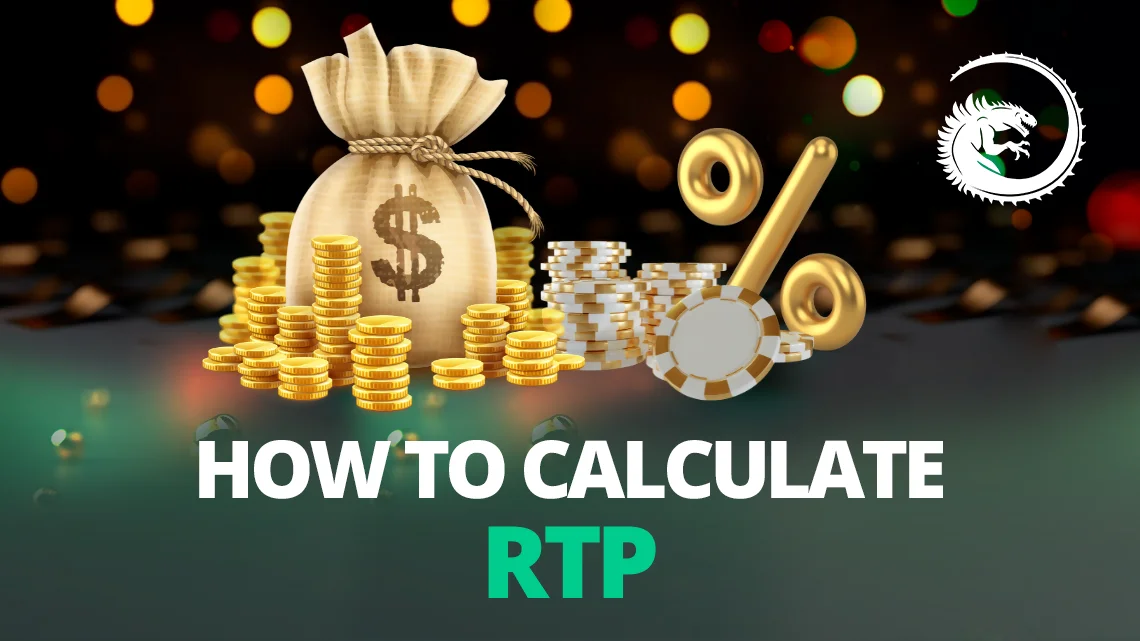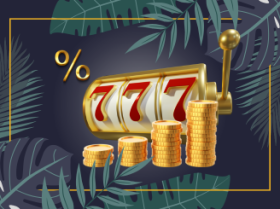RTP is a simple way online casinos tell players how much they can expect to win while playing a particular game. Figures are presented as percentages, with 100% as the maximum value. In most instances, games sit somewhere between 90% and 99%.
For example, an RTP of 97% tells us that the game should pay out $97 for every $100 wagered over a tried-and-tested period. This may sound enticing on paper, but there’s much more to an RTP than meets the eye. In this guide, we walk you through everything you need about Return to Player and similarly crucial terms.
What Does RTP Mean?
At face value, RTP is an abbreviated term for Return to Player. ‘Return’ represents money, and the ‘Player’ engages in the online casino game. Essentially, RTP is used as a guide to convey how much bettors should win during an extended play session.
However, this isn’t the entire story. RTP is just one detail among a larger pool of information, with things like volatility, variance, maximum winning values, maximum wagers, and hit frequency all entering the equation.
So, knowing all this, why is RTP held in such high regard? More importantly, can we trust its figures? We need to dig deeper and examine how RTP is calculated.
How to Calculate RTP

In an ideal world, casino game developers would use an equation to determine their games’ RTP. The reality is much more complex—studios rigorously test projects and compile data before achieving a final RTP figure. Let’s look at some factors that come into play when tallying up a game’s RTP.
The Role of RTP in Game Development and Marketing
Every company wants its next project to take the world by storm. Developers must first lay out a plan to become one of the industry’s favourite games. That plan always includes an ideal RTP. From here, software developers can test games accordingly and determine whether or not the game falls short of or exceeds the expected value.
Even more pertinent to the game’s success is the marketing opportunity with a solid RTP – another detail considered during the early design phase. The RTP of the game is more or less known from the early days of the title’s design.
Mathematical Equation
Mathematical equations are at the heart of every casino game ever released. In addition to other features, software developers use math to develop a final RTP figure. This goes hand in hand with the game’s design, as developers can compare and contrast expected RTP values with actual RTP values through testing.
Put simply, RTP is calculated by dividing the win amount by the turnover amount over a set period. For instance, imagine a game with $1,500,000 turnover that sees players win $1,440,000 over a month. The equation in this case is: 1,440,000 ÷ 1,500,000 = 0.96
This comes to an expected RTP of 96% for a month’s play. The team is on the right trajectory if the casino game targets this figure during testing. If they aim for lower or higher than this amount, the studio will do further tweaks to ensure the game meets the correct requirements.
Pre-Release Testing
It’s all good for a studio to test its games, but third parties must get involved at some point during the process to ensure that the studio is operating fairly and transparently. This is why you’ll often see certifications on online casino sites, games, and developer platforms—regulatory checks are highly regarded in the betting industry.
So, on top of in-house testing, outside entities will conduct in-depth analyses of all games slated for release. If a game’s RTP exceeds its expected mark during this project phase, the software developer may be forced to delay the entire release. Look out for eCogra upon selecting a game – this is a marker that a highly regarded testing team has evaluated the project.
RNG – Random Number Generators
Amongst all the fuss surrounding RTP and expected values, it’s easy to forget that outcomes are entirely random. This is where things like volatility and hit frequency come into play—highly volatile games are more likely to leave players without a win for an extended period. By using RNGs, studios ensure that every bet is unique.
Regulatory Requirements
Studios must comply with rules set out by regulatory authorities and regional gambling laws before releasing a game. Although rare, some locations enforce minimum RTP rates – with one of Australia’s most popular retail venues, Crown Perth, dedicated to supplying games with an RTP of 90% or better. Developers must adhere to RTP rules wherever they plan on releasing a game.
Fairness & Honesty
Boasting a tremendous RTP rate is good for the operator and the customer. It benefits the online casino, as the site is free to roll out an entire marketing program on its high-RTP games while customers enjoy rewarding slots across all genres.
Online casinos and software providers know RTP’s role in bettors’ minds. Hence, most games on reputable websites carry enticing RTP percentages. It simply wouldn’t be prudent to showcase a game with an RTP barely scraping 50%, 60%, or even 80%.
How RNG’s Influence RTP
How can games carry a guaranteed RTP if a random number generator is truly random?
Many online casino players ask this question, and it’s understandable. In short, many casino operators use a pseudo-random number generator to meet the RTP rate.
Essentially, this RNG software operates within specific limitations. The software provider tells the generator how often certain outcomes should occur, and the computer gets to work. Every outcome remains entirely random, and each symbol is unpredictable, but the RNG software maintains the RTP rate over an extended period.
This is why third-party testing is of utmost importance. Outside entities regularly check on the latest RNG software and linked games to protect against unfair RTP practices.
RTP in Different Games
Slots, roulette, blackjack, baccarat, live casino action, and more—every casino game has an RTP. This figure translates to the amount of money you should expect to win while playing one of these games, with higher figures amounting to greater returns. Here, we discuss how to find the RTP when playing games across multiple popular game genres.
Slots
RTP is heavily linked to slots as software developers regularly use higher values as part of a more comprehensive marketing strategy. The oversaturation of the modern slots industry makes it difficult for games to stand out – hence the eagerness to tell players that they can expect to win regularly. Slot RTP rates are generally found in the ‘Help’ section of the game, the software provider’s website, or the online casino you’re using.
Blackjack
Traditional casino games, like blackjack, often use ‘House Edge’ and RTP. The term ‘House Edge’ refers to the amount of gross revenue an operator or online casino expects to earn from wagers during a playing session – and the formula for this is quite simple.
Just subtract the stated house edge from 100. The result is the RTP for that specific blackjack title. For example, a game with a house edge of 1.5% comes to 98.5%, bringing the RTP from the house edge alone to 98.5%. A separate figure for RTP usually assists the house edge, but the casino does not decide this. Pre-set RTP rates can be found within the ‘Information’ or ‘Help’ areas on the game’s page.
Roulette
Like blackjack, roulette uses the house edge rule on specific sites. Whatever the house edge figure is, just subtract it from 100 to see your expected RTP from the house edge alone. Again, most games come with RTP rates set by the software provider, so watch for specific RTPs before playing roulette.
Remember, roulette is a unique game where the RTP varies depending on the colour in question. The figure for a bet on red or black floats at around 47% to 48%, respectively, while a chance bet sits 10% to 12% lower. Everything hinges on the roulette game being played, with differing figures for European, American, and live roulette.
Baccarat
Your RTP value for Baccarat will vary depending on whether you play the live version or a non-live product and whether the house edge is present. You should expect an RTP of 98%+ while playing Baccarat, with a standard house edge of 1% or more.
Why Is RTP So Important?
Games tend to advertise special features, bonus rounds, free spins, high payouts, low minimum bets, and more – but none of these features matters if the RTP sits on the low end of the scale.
RTP is a vital cog in the casino gaming machine, with every feature centered around its value. Your wins and losses are virtually predetermined by the number the RTP holds. The lower the number, the more likely you will see fewer winnings, and vice versa.
However, the main reason RTP is influential in the casino space is that its values most affect consistent players. For short-term sessions, RTP matters little. Your outcomes are far likelier to be influenced by volatility and variance during a quick game. The longer you play a particular title, the more you should notice the influence of RTP.
Volatility should even itself over time, as early losses in a highly volatile game are expected to be followed by wins later. You should reap the rewards of a great RTP if you continue betting on the same game.
Why RTP Rates Vary
Regulars in the online casino scene will notice that the RTP for seemingly similar games can differ wildly. Why? There are a few reasons.
- Targeted RTP: The software provider may have targeted a specific RTP value while creating the game.
- Unique Features: Some games host special and unique features that cause the RTP to fluctuate.
- Variable RTP: In some instances, games pack variable RTP rates. Although relatively rare, this is entirely normal.
- Volatility: Lower volatility means you’ll notice the RTP take effect quicker, whereas higher volatility means it’ll take a while for the RTP to play out.
As mentioned earlier, each element is involved when gaming studios develop games. For this reason, you should never take RTP on its own. See the next section for further details.
Other RTP Factors to Consider
RTP gets the headlines due to the frequency at which online casinos throw high numbers on your screen. You’ll rarely encounter a platform showing off its volatility, frequency of bonus features, variance, and algorithms. None of these are straightforward to advertise – and even fewer carry impressive numbers in the 90%+ range.
We’ve defined other essential factors that should be considered alongside RTP here.
- Hit Frequency: On average, how often a winning combination will land.
- Paylines: The number of lines on which a winning combination is achieved.
- Bonus Features: Special games and rounds that bolster the all-round experience.
- Maximum & Minimum Bets: How much can you bet on a single round?
- Variance: Considered a phrase for volatility over a longer period.
- Symbols: The images you match to create a winning combination.
What Is a ‘Normal’ RTP?
Before we discuss this topic, we need to change our mindset. ‘Normal’ is a state of mind, not a fact or statistical value. Instead of using the word ‘normal’ to determine whether we like an RTP in a specific genre, let’s look at things using ‘averages’.
The ‘average’ RTP rate is the industry standard for Return To Player values. The average for one game might be considered poor in another, so avoid looking at things on a broad scale. Instead, hone in on themes, genres, and gameplay styles.
For example, the RTP for slot games shouldn’t be compared with roulette as they’re so different in almost every way. Slots should be pitted against other slots – with higher RTP rates representing an improved chance to win in that genre.
The average RTP for slots in the online casino space is between 90% and 99%, but that’s such a wide margin that it means very little. As a general rule of thumb, seek out games with RTP rates of 95% or higher for experiences on the higher end of the scale. But with the average RTP calculated throughout up to 100,000 playthroughs, the value associated with a game may not translate to your experience unless you play for days on end.
Can RTP Be Manipulated?
Technically, RTP can be manipulated by the software developer and the online casino publishing the game. It’s unlikely—primarily because it would ruin the platform’s reputation—but far from impossible.
Online casino sites use algorithms to ensure every game pays out as expected. A change to this algorithm could sway the RTP metric, leaving players in the dark about the true value of the current RTP.
Licensed online casinos are not allowed to edit the RTP of any games. Most licenses require that the online casino lists the RTP for every game to ensure that players are ‘in the know’ across every title. Failure to meet this requirement will see the site’s license revoked, with the potential for further punishment also possible.
However, while researching various player forums, we found opinions provided by experience that studios such as ELK are now releasing their slots with only one RTP of 94%. They used to be 96%+, then it was quiet, all new releases were 95%, and their last few releases were 94%. Also, except for Big Time Gaming and a few smaller studios, all online slots are now produced in several variants. For example, the RTP for the demo version will be higher than for the same slot for real money.
Signs of RTP Manipulation
A 2020 scandal saw one casino site at the centre of a significant RTP controversy. Players reported that the platform, Vavada.com, had changed the RTP of Play’N Go games. This prompted community discussion about whether gaming sites and developers act in players’ best interests. In the case of Vavada.com, RTP rates returned to normal after bettors had uncovered the issue—but the damage was already done.
See how to watch out for RTP manipulation below:
- Meagre payouts: If a game boasts an RTP bordering on 99% and low volatility, yet pays out very little and not very often, it might be time to question the authenticity of its RTP.
- No RTP listed: Most licensing bodies require sites to publish RTP rates for every game, so failure to do so should be considered a major red flag.
- Multiple concerning reports: If a flurry of players suddenly experience the same issue with RTP, consider that the provider is manipulating the RTP.
With all this said, it’s uncommon to see RTP manipulated by the casino or software provider. You can avoid such an issue by sticking with licensed and legal platforms—the Curacao Gaming Control Board, UK Gambling Commission, and Malta Gaming Authority are renowned bodies to look out for.
Is RTP a Marketing Trick?
The answer is two-fold: yes and no. RTP is undoubtedly part of a more comprehensive marketing program – with higher rates advertised to players. As for the ‘trick’ aspect – is it possible to be tricked into something when its value is a matter of fact?
Since the percentage for RTP rates is calculated throughout 10,000+ spins, players are not experiencing the 95%, 96%, or 97% + advertised. The truth is this: you are experiencing a portion of the RTP described. To see the accurate scale of an RTP, you’ll need to play thousands of rounds of the same game. From this, we can deduce that RTP is included in marketing schemes and material but is not a trick or a ploy.
Are High RTP Games Popular?
The popularity of games with a large percentage of RTP does occur, but it always depends on various factors. We have determined what this popularity depends on and provided the facts below.
- Reviews: The opinions and experiences of other players are always part of a game’s success or, conversely, its lack of popularity.
- Player Preferences: For some players, the theme of the game, its rhythm and the resulting entertainment is the goal of the gameplay, so such players are not very concerned about RTP. While some players prefer the potential for more significant wins, others favour steadier, smaller winnings, making them inclined towards games with higher RTP.
- Risk Tolerance: Players’ risk tolerance is always different. Some are willing to take risks to accept a lower RTP. Others prefer more stability and, without relying entirely on luck, like games with a higher RTP.
Therefore, bettors should look for games that combine volatility and high RTP to get the best value for money. A highly volatile game with low RTP means you’ll see infrequent yet impressive wins, while low-volatility games with high RTP rates often pay out in smaller increments. The most popular games deliver a mixture of both.
Conclusion
Both beginners and veterans of the online casino world must understand RTP. While the importance of ‘Return to Player’ rates is overstated in some corners, it remains a vital element of any casino game.
As we conclude this guide, here are some pieces of advice. First, avoid games with ridiculously high RTP rates and volatility – you’ll set yourself up for disappointment. These games will run your bankroll dry. Second, always set a budget for the game you want to play. If a game demands patience, fit your budget around it.
Above all, remember that RTP is just another piece of the puzzle. It’s readily marketable as its figures often hit over 90% – leading some bettors to believe a win is a sure thing. Before betting, check out the game’s volatility, bet sizing, and unique features. Combining all these features is much more important than a simple one-and-done figure for RTP.








